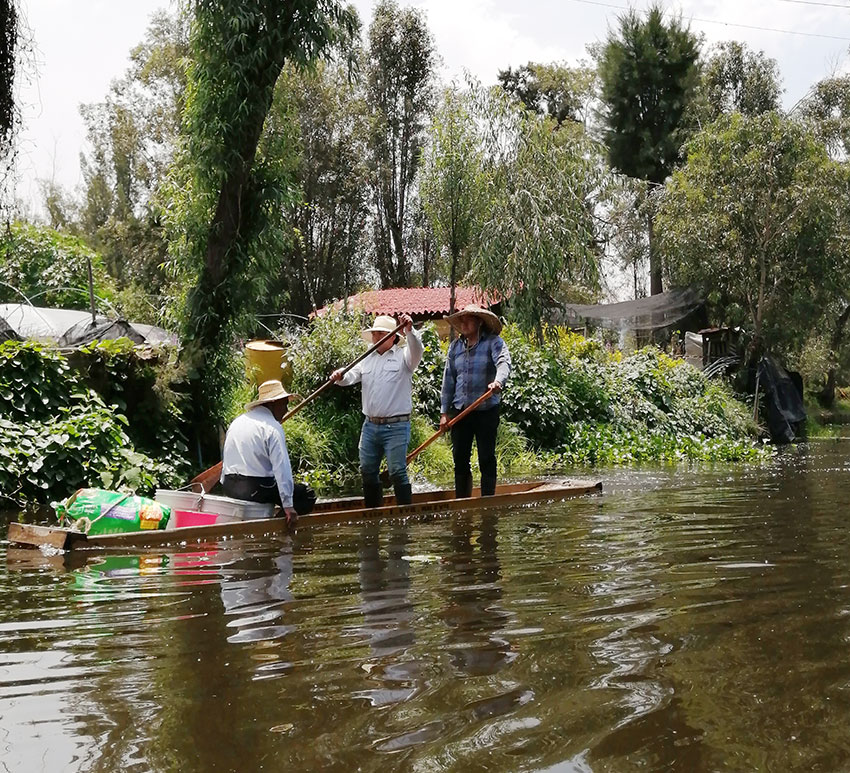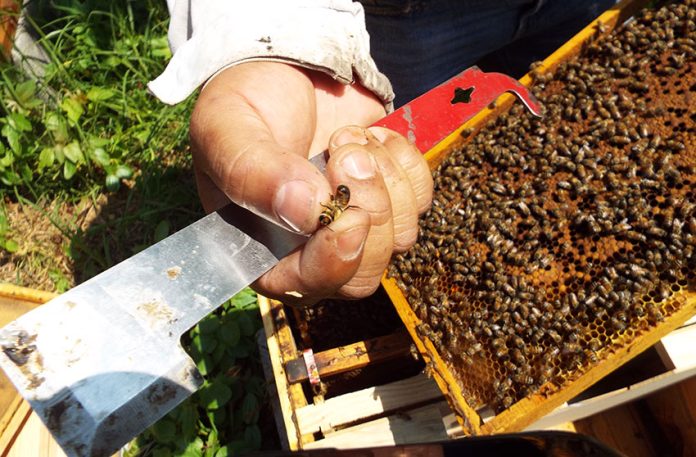A double layer of clothing under the central Mexico sun, along with this infuriating face mask that I am diligently wearing, are creating little waves of heat that roll over me. A full body suit and gloves also make a camera, voice recorder and cell phone pretty difficult to manage.
But as the hive opens any annoyance drifts away.
Hundreds of tiny bees buzz so intensely I can hear them as if they were inside my chest. Dante Moreno from Abejas de Barrio is gently smoking an open hive to calm the bees so we can get a closer look at what is going on inside. Unlike the rest of us, he is only wearing a netted hat, his hands bare as he slides each wooden frame from the bee box to inspect it.
He’s marked the queens to be better able to find them at a glance and with his bare hand picks her up to show us the difference in her size from the other worker bees. He places a little honey on her wings and she shuffles in a slow sticky walk across the wooden lid.
It’s not often that you get to up close and personal with honeybees. In fact, as members of our morning tour are discussing, when Africanized bees were discovered in Chiapas in the 1980s, the fear of this aggressive hybrid bee tarnished the pollinators’ reputation throughout Mexico, leading to popular campaigns to destroy hives found in urban areas.

“It became ‘cool’ to be afraid of bees,” says one of the women in the group.
But an intimate look at a beehive and the incredible ingenuity and coordination of the bees will set you to thinking about these small and important creatures.
Eighty-seven percent of all flowering plants are pollinated by animals and among them bees are the main pollinators. That’s about two-thirds of the cultivated crops that are used to feed the world. Without bees we humans would be in serious trouble trying to feed ourselves, not to mention the loss of biodiversity that might mean the destruction of cures and vaccines for diseases yet to come.
But despite their vital importance, disappearing they are at an estimated decline of 30%-50% yearly in the past several years (a normal year’s winter loss is around 10%-15%). The rising loss of bees worldwide is blamed on a lot of factors. Air and water pollution, the destruction of habitat, rising temperatures due to climate change and intensive, pesticide-heavy, mono-crop agriculture are a few.
A 2018 study looked at the previously unknown effects of glyphosate, commercially known as Roundup weed killer, on honeybees and found that the herbicide changes the gut bacteria in bees in such a way that it makes them susceptible to harmful pathogens and impairs their spatial processing. This means they have a harder time getting back to their hives, finding flowers they’ve scouted and staying healthy. The researchers believe this may be contributing to the collapse of colonies worldwide.
If you are paying attention to the news you know that the Mexican Ministry of Environment has urged that the use of glyphosate be phased out over the next few years. (A presidential decree is expected soon, according to the outgoing minister of environment.) It’s a strong step in the right direction. Still, other issues may be a bit more complicated to resolve and Mexico City beekeepers are living in a microcosm of those worldwide factors.

To reach the 27 hives managed by Abejas de Barrio requires a watery journey. The project, run by Sandra Corales, rents a small chinampa in the southern canal system of Mexico City near Xochimilco. The bees they are raising are Apis mellifera, sometimes called the western bee, that were imported into Mexico in the 19th century by Europeans as the original bees of the chinampas are pollinators but don’t produce honey.
The Abejas de Barrio project is an offshoot of Corales’ early work assisting other local beekeepers, which she did until she was able to set up her own hives and start producing her own honey. Raising bees in the chinampas has its own unique difficulties. Among the greatest is the nearby human population.
We pass a local woman and after a few pleasantries she starts to tell Corales about seeing some bees in the area, a decidedly nervous tinge to her voice.
“But you just saw one?” asked Corales. “Or you saw a hive? Did you see a lot of bees in one place?”
Corales does her best to reassure her neighbor that they are taking all the necessary precautions to make sure their bees are mellow and happy and to keep them from people’s fields and homes. The woman doesn’t look completely convinced, but says she will let her know if she sees them again.
“That must happen all the time,” I say.

“Yep,” says Corales with a sigh.
It’s hard to maintain a balance between humans and nature. As the city encroaches on the chinampas, an area historically agricultural, that balance is constantly put to the test. While this area is one of the greenest and wildest within the capital, the bees still lack for sufficient food sources and Abejas de Barrio “feeds” its bees with sugar water to keep up production.
According to Moreno and Corales, once upon a time beekeepers could once harvest twice a year in the chinampas, but now it’s only once. In Yucatán, which is the largest producer of honey in the country, beekeepers can harvest up to 10 times a year.
“I would love to see this area reforested, with native plants and flowers,” says Corales wistfully, but unfortunately, the opposite is happening.
Despite its protected status, this area of the city is often neglected by its own residents and the local government. The waters of the canals are extremely polluted from illegal dumping and poor water filtration. Corales says they have plans to install a drinking fountain for the bees to provide them with purified water.
Despite the complications, Abejas de Barrio is working to encourage more people to get interested in bees and beekeeping, hoping that will be one way to safeguard their existence. They offer workshops on everything from sustainable beekeeping to making your own beeswax lip balm and they also offer tours, similar to the one we are taking today.
Guests receive a formal honey tasting aboard a trajinera boat and then zip up into individual bee suits to get up close and personal with the hives.
The hope is that these experiences will give people a greater understanding about bees while at the same time support the local economy and the continuation of the project. At the very minimum, a visit to the bees offers an opportunity to see their unique watery environment and leaves an impression not soon forgotten – your head will be buzzing for hours.
Lydia Carey is a regular contributor to Mexico News Daily.
